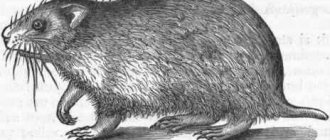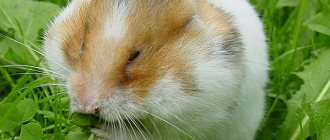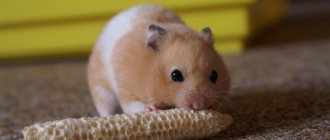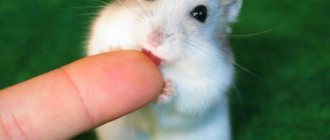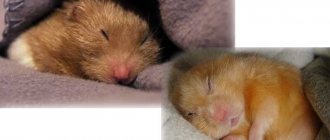Their teeth never stop growing
Like all rodents, hamsters' incisors have no roots and never stop growing. By gnawing on solid foods, chew toys and sticks, hamsters keep their teeth healthy and sharp and prevent overgrowth.
Researchers studying rodent teeth have discovered that their incisors contain active stem cells. This factor, coupled with the fact that rodents constantly regenerate teeth, gives scientists hope that one day they will be able to reproduce the process of tooth regeneration in humans.
Hamster teeth
Category: Care and maintenance • Published June 04, 2021 • Author: Khrumik •
Overgrown and crooked teeth prevent the hamster from eating normally, he loses weight and dies from hunger. The first symptom of overgrown teeth is that the animal wants and cannot eat, for example, it approaches the food, takes it and throws it. There is severe salivation (the chest and stomach are wet).
So that the hamster can grind its teeth, place a wooden stick (apple tree, birch, the size of a little finger, boil for 1 hour) in the cage.
Read more…
Hamsters are thrifty
The word "hamster" comes from the German word "hamstern", which means "to store." Even domestic hamsters will hoard food, despite the lack of such a need. Their cheeks are like tiny bags, which they fill with fruits, grains, roots and leaves. When they find an abundant food source, they fill their cheek pouches and return to their burrows, where they have previously prepared food chambers to store food.
Photo: ISTOCK
The filled cheek pouches can cause a hamster's head to appear twice or even three times its actual size. They have other uses as well. By filling their cheek pouches with air, some hamsters float through the water like an inflatable raft.
What types of hamsters are there? Photo and title
There are both species of hamsters that are quite familiar to us, as well as very rare and unusual ones. Each of them has its own distinctive features of appearance and habits. Here are the most common and interesting breeds of hamsters:
Djungarian hamster
Perhaps the most popular home species. They are small, but not quite tiny - the body length is approximately 10 cm. In the middle of the back, from the back of the head to the base of the tail, there is a pronounced dark stripe. At the top of the head it turns into a triangle, going down to the nose. The rest of the fur is smoky gray with small white areas. There are also specimens of other colors - with a bluish, pearl or red tint. Dzungariki require careful care. If you don’t tidy up the cage in time, a very unpleasant smell, reeking of ammonia, will spread throughout the apartment. Therefore, ideally, home cleaning should be done daily.
Taken from Wikipredia.com
Posted by Wilson Aniston
Field hamster (wild hamster, forest hamster)
People also call this animal “karbysh”. The peculiarity of this breed of hamster is that it almost never digs minks itself, but takes them away from other rodents like gophers. Having taken possession of the home, the karbysh adds to it a couple of extra entrances and exits and separate “rooms” for the toilet, sleeping and storing supplies. The result can be a real intricate labyrinth up to eight meters long.
The field hamster is quite aggressive towards anyone who potentially encroaches on its place of residence. It will literally fight to the death for its territory, and it doesn’t matter what size the enemy is - often the animals even attack large dogs or people. The animal's teeth are very sharp and grow throughout its life, grinding down as the field hamster gnaws on something. Before attacking, it often rises on its hind legs, snaps its teeth and makes threatening sounds.
The size of hamsters of this breed can vary from 5 to 37 cm, if you do not take into account the length of the tail, and weight - from 45 to 700 grams. They have rather large, round ears, and their paws are always white. Thick fur, combined with undercoat, allows the animal to survive the frosty winter. But, in addition to frost, the animal has many enemies among the animal world - from rooks to foxes. Farmers are also opposed to them, whose crops the animal can seriously damage.
From October to February, the field hamster hibernates, slowing down all metabolic processes. When it gets warm, he does not crawl out of the hole right away, but first eats up all the supplies left over from the fall. By that time, the mating period has just begun, during which this wild hamster is very active.
Author: Adams Moran
Common hamster
The most common representative of the species. Its average body length is 35 cm, and the body ends with a thick, strong tail 5 cm long. The ears are short and dark, the belly is also dark, but the upper part of the body is usually golden. The common hamster lives in the steppe and meadow zones of Europe, rarely rising above 1.5 km above sea level.
The animal's diet includes various parts of herbs and other plants. In the fall, mainly seeds and tubers are used, the same is suitable for stocks for the winter period. Amazingly, this little animal can speak up to 15 kg of food. The most common items collected in the “pantry” are peas, corn, selected cereal grains, potatoes, millet, and lupine. The pantries are always in order, even seeds of different varieties are stored separately from each other.
Author: Aiti Kiperman
Two or three times a year, mainly in late spring, the common hamster reproduces. Usually each litter brings from ten to twenty small animals. Three weeks after birth, they can already switch to adult plant food, as well as some animal food (insects). In October, the rodent goes into hibernation, but it does not sleep continuously; sometimes it can wake up and have a snack when it is warmer than -20C outside.
The common hamster is included in the list of animals protected by the Berne Convention, founded by the Council of Europe in 1976, and it is also listed in the Red Book of the Lipetsk Region. This species is often kept in a cage at home as pets. He can live well at home, but here some nuances should be taken into account. First of all, this is hibernation. Also, an ordinary hamster can significantly damage furniture and wires with its teeth, and in adulthood show inexplicable aggression. However, the animal quickly forgets the insults and becomes peaceful again. It can even be trained, and it reproduces well in captivity.
Author: Misha Fisenko
Angora hamster
This breed is mainly distributed in Central Asia and both American continents.
The hamster's coloring perfectly matches the animal's natural habitat. But the Angora hamster can have absolutely any colors. In the middle of the 19th century, these hamsters began to be bred in captivity; soon breeders managed to breed individuals with long fur, the shade of which ranged from silver to black. So today, anyone who wants to buy an Angora hamster will have a wide choice.
Many sources often confuse the concepts of “Angora hamster” and “Syrian”, claiming that they are one and the same thing. But in fact, the Angora is only a variety of the Syrian, which has only a sandy shade of fur.
Caring for an animal of this breed is not much different from caring for other hamsters; they also need a clean, comfortable cage, good food and water. But there are added concerns about keeping the fur in good condition, otherwise it will quickly become dirty, matted and look unsightly. However, you cannot bathe the animal, it is dangerous for it. Provide him with a sand bath where the Angora hamster can clean his fur on his own. But do not forget to comb the coat regularly to prevent matting.
Posted by: Matthew Kitler
As for food, it should be taken into account that Angoricas are bred at home, which means they are more picky about their diet than their wild relatives. Its basis is grain crops, which saturate the body with fiber, and its addition is nuts, vegetables and fruits, rich in plant protein. The Angora hamster can happily eat flax, millet, tomatoes, and pumpkin. Of the seasonal fruits, it is allowed to give him pears, apples, and grapes. Other products include fermented milk and boiled chicken. The main thing is not to overdo it with unusual nutrition and, of course, all products must be impeccably fresh.
Author: Ivan Odnekovsky
Campbell's hamster
This animal belongs to the dwarf hamsters; it was discovered in 1904 on the border between Russia and China. Externally, the Campbell's hamster can be similar to a dwarf hamster, which is why they are often confused. It has a pleasant amber or sandy fur color and a dark stripe along its back. There is no hair on the paws, and this species does not change its coat for winter. This type of hamster lives shorter than others - on average 2 years.
There are two main types of color that a Campbell's hamster can have. The first is agouti, where the top of the coat may look a little darker as it gets closer to the roots, and there are lines on the sides separating the back from the belly. The second is selfie, when there are no stripes on the back and sides, the color is almost uniform, with the exception of minor spots on the chest or belly. The hamster's fur grows unevenly, as if in clumps, because it is directed at an angle.
Author: Maria Shepova
The Campbell's hamster is so tiny that its weight barely reaches 50 grams and its height is up to 10 cm. Its character is quite complex, and care should be taken not to get bitten by sharp teeth. Due to its size, a small aquarium can be adapted for the life of a rodent. However, if you have a whole family of hamsters, then they need a lot of space - otherwise there will be constant fights. The cage or aquarium should be in a fully illuminated place, but a window sill is not suitable for this - there the animal will be tormented by drafts and direct sunlight, and there is usually a hot radiator under the window.
Campbell's hamster breeds over a period of six months, from March to September. Pregnancy lasts for 2-3 weeks, after which the female can give birth to 3-4 cubs. The babies will grow fur on the fifth day, and open their eyes on the tenth.
Author: Konstantin Abramov
Roborovsky's hamster
This is another dwarf breed that is sure to be loved by those who dream of a small pet. This species is native to Asian deserts, particularly Mongolia and China. In the Russian Federation, it can also be found in the wild in mountainous regions near the Asian borders.
This is one of the smallest hamsters in the world - its length from nose to tail tip rarely exceeds 5 centimeters, and its weight is 25 grams. Round ears are set high on the head, the eyes are slightly bulging. The species is distinguished by its snow-white brow ridges, reminiscent of a mask. The hamster can jump quite quickly due to the fact that the front legs are shorter than the back legs.
Like many desert hamsters, this breed has a sandy coat color, but many other colors have been developed through genetic mutations. But, it should be borne in mind that animals with unusual colors are much weaker in health. In general, these hamsters are very active, they are constantly on the move, literally never sitting still for a second. At the same time, they almost never bite, having a peaceful disposition. But it’s unlikely that Roborovsky’s hamster will allow himself to be calmly held in his arms and stroked while watching TV - this is not in his character. The animal may become frightened and become very stressed.
Despite their tiny size, this breed of hamster needs a spacious cage where they have plenty of room to run and climb. And the more “tenants” there are in the cage, the larger its size should be. It is best to use an aquarium made of glass or acrylic with a wall height of at least 20 cm for keeping the animal. However, the glass can fog up. So you can consider another option made of plastic. A cage with bars is unlikely to be suitable - the nimble rodent can get through even very small holes.
Posted by Kasandra Nikson
Author: Eduard Agapov
Sungur hamster
It differs from its relatives in that it stays awake a lot during the day, giving the opportunity to fully communicate with it. It comes from desert and steppe areas of Asia and Western Siberia. In the wild, this hamster can cover vast territories in a day in search of food and a burrow. The appearance of the animal is remarkable - it has large shiny eyes of black or reddish color. The fur is smoky and very soft.
During winter or autumn, the animal's fur begins to lighten - so it was also given another name, Russian whitening.
Author: Nikolay Stepanich
Taken from wikipedia.com
European hamsters are endangered
There are 19 species of hamsters, but only one species, the European hamster, is now critically endangered. Once widespread throughout Europe, the black-bellied European (or common) hamster is critically endangered. It is the only representative of the genus Cricetus. Its range and population have declined significantly in Western, Central and Eastern Europe. Changes in agricultural practices, commercial and residential development, pollution and climate change are the biggest threats to these small rodents.
These are very territorial animals
Photo: Frank Scherbarth
These rodents must live on their own as they are territorial mammals that value their personal space to the point that they will fight each other if personal territory is invaded. This aggressive behavior is especially common among Syrian hamsters. Once they reach maturity, which is 8 to 12 weeks, they should not be kept in pairs or groups. Even the scent of another adult male in the same house can cause irritation, so it is best to always keep only one male.
What to feed a baby hamster
Category: Care and maintenance • Published June 10, 2021 • Author: Khrumik •
Many people ask: what to feed a hamster at 2-3 weeks?
It's a pity that you left your hamster without its mother so early. He is supposed to be with her for up to 4 weeks, because with mother’s milk the baby receives protection from diseases (immunity).
In addition, at 2 weeks it is too early for him to eat like an adult. Now it needs to be fed with water-based porridge, protein foods and cottage cheese (low fat to 0-1%). Attention: it is written here in detail what and how to feed the hamster - only protein foods and cottage cheese should be given more often so that the body develops better.
Read more…
They have one of the shortest gestation periods in the class of mammals
The gestation cycle of a hamster lasts from 15 to 25 days. But if the conditions for birth are not right, they can delay birth by as much as nine days. They give birth to up to four litters per year. Females are very fertile and after giving birth they can become pregnant again on the same day.
But their parents are so-so. It is not uncommon for females to eat their young or abort a pregnancy if the male is not around. Most scientists believe that hamsters do this when the litter is too large and the resources needed to fatten the young are limited. There can be up to 18 cubs in a litter.
Photo: www.pets4homes.co.uk
These are crepuscular animals
Most hamsters are active during twilight hours. Experts believe this is due to the fact that this is when insects, which are a natural part of the rodents' diet, are most active. There is also less light, meaning they are less likely to be caught by predators.
Syrian hamsters are nocturnal, which means they will stay awake at night, burrow, chew, play, and make noise. This is a very important fact to consider before getting a hamster.
Hamsters love to run
Most hamsters are very fast runners, and the shape and size of their hind legs allow them to even run backwards. They can travel up to 15 km per night with a fair wind. Domestic rodents most often run around inside wheels. But if the wheels are too small, they can cause pain, spinal problems and even lead to arthritis. Some hamsters will adamantly refuse to use a wheel that is too small, resulting in unhealthy levels of inactivity. Wheels made from mesh or bars can also be bad for them because they can get stuck or get hurt.
They have very poor eyesight
Photo: ISTOCK
After hamsters are born, it takes almost two weeks before they open their eyes. But even then, they are at a disadvantage because they are nearsighted and colorblind. Hamsters use their whiskers and sense of smell to navigate. Try not to touch their nose. They have trouble seeing objects at close range, so when you approach their nose with your hand or finger, it may surprise them. They will become nervous, bite their finger, or simply run away in search of shelter.
Diabetes in dwarf hamsters
Category: Homotherapy • Published January 06, 2021 • Author: Khrumik •
Diabetes is a pathology of the pancreas that stops producing insulin (the hormone responsible for the absorption of glucose).
At the same time, the hamster experiences increased thirst and often pees a lot. The disease is hereditary, predominantly in Campbell's hamsters, but is increasingly found in other dwarf species. A person provokes the disease by giving the hamster various treats that are difficult to digest. Even carrots can be dangerous for a dwarf hamster, and even more so sweet fruits and honeyed grain sticks.
There is no treatment, but it is necessary to try to control the diet to help the animal maintain viability.
Symptoms of diabetes in a dwarf hamster:
- behavior changes - lethargy or increased activity (itching, running back and forth, digging, jumping);
- severe exhaustion or obesity;
- drinks a lot and, accordingly, pees. The drinking rate for a dwarf hamster is 10 ml per day.
Special diet
Sweet and colored (colored) foods, red and orange vegetables are prohibited. The diet includes more green and white vegetables - zucchini, cucumber (without peel), Chinese cabbage, lettuce, non-bitter radish, celery, Jerusalem artichoke. Limit fats (nuts, sunflower seeds), give low-fat cottage cheese, boiled meat and egg whites.
We recommend reading this material: DIET for DIABETES IN Dwarf HAMsters
How to test for sugar in urine
To find out if your hamster has diabetes, you can use test strips. It is believed that the composition of human and hamster urine is different, and the test strips will not show the desired result. But in practice they work.
Buy test strips for determining urine sugar levels at a regular pharmacy (for example, Uriglyuk). During the day, do not give your hamster foods that may contain sugar. In the morning, place it in an empty, clean, dry container and wait for it to pee. Use a syringe to collect a drop or two of urine and apply the test strip according to the instructions. If the glucose norm is significantly exceeded, given the combination of other symptoms, the hamster can be suspected of having diabetes.{jcomments off}
They are susceptible to bacteria and viruses
Hamsters carry salmonella and are also susceptible to lymphocytic choriomeningitis, a virus with symptoms similar to the flu. Children under 5 years of age and pregnant women are especially at risk. The main methods of transmission of zoonoses from hamsters and other rodents to humans are bites, direct contact with the animal, and indirect contact with contaminated objects.
How to determine the sex of a hamster?
This information may be important if you keep several animals at once and do not plan to reproduce them. Finding out what gender an animal is is not very difficult. To do this, you need to examine him, but this should not be done abruptly so that he does not get stressed. Calm the animal down and treat it to something tasty. Gently take the animal in your arms and hold it on the fold of skin between the shoulder blades, but do not pull.
Inspect the back. Males have pronounced sexual characteristics, but females do not. You can presumably determine the sex simply by the size of the animal - males are usually much larger than females. The latter also have prominent nipples in the abdominal area. Determining the gender of a newborn animal is somewhat more difficult. This can be done along the gap between the anus and urinary opening. For girls this distance is usually less than for boys.
A hamster will never bite unless there is a reason for it.
Many people are nervous when handling hamsters due to the fear of being bitten. Yes, a bite can cause severe pain, but if you follow these rules, this will never happen:
- Avoid loud noises, do not keep them near TVs or stereo systems that produce high-frequency sounds;
- wash your hands. Hamsters have poor eyesight but a great sense of smell, and if your hands smell like food... you can bet your hamster will want to try them;
- let them wake up on their own, don't wake them up to play. Instead, schedule your communication for late afternoon or early evening after they are well rested;
- be gentle. Rough touching, sudden movements, grabbing or poking can frighten them and make them nervous. Always scoop them carefully with both hands and stroke them very gently.
Over time, hamsters will adapt to interacting with you, and after a few weeks they will even be waiting for you in their enclosure, ready to play.
Hamster care
Keeping and caring for a hamster at home is a simple process, but it requires certain knowledge and care. You can determine whether your animal is feeling well by such signs as shiny fur without bald spots, a clean nose and eyes, even breathing, and the absence of digestive disorders. Since the pet usually sleeps most of the day, it is better to assess its behavior in the late afternoon, during the period of activity.
Cage for a hamster
Caring for and keeping a hamster at home always starts with choosing a good cage. They come in plastic and lattice. Plastic container-like ones are most convenient for dwarf hamsters (Roborovsky, Campbell, and dwarf hamsters). But lattice ones are perfect for golden (or Syrian) breeds. The main thing is that the bars of the cage are placed horizontally so that the animal can climb the walls. The gap between the rods also depends on the specific type - for golden, a distance of 1 centimeter is acceptable, for smaller types - less.
If the distance between the bars of the cage is incorrect, the animal may unsuccessfully stick its head between them and die from suffocation.
The next step in caring for an animal at home is to properly equip its “apartment”. It starts with the choice of bedding - both the comfort of the rodent and the time you will spend cleaning the cage will depend on this. It is advisable not to use newsprint as bedding, otherwise your pet may be poisoned by printing toner. In addition, such paper does not absorb liquids and odors well. However, the same applies to ordinary paper or cotton wool. Cotton wool in a cage is also not recommended because the animal's small paws can get tangled in it.
Fillers such as sawdust, hay or wood shavings are better suited. But some animals are allergic to ready-made wooden pellets. Corn (chopped cobs with a few grains left) is recognized as the best option for filling the cage. It is very light and pleasant for the animal. This filler is more expensive than others, but it retains the smell for up to ten days.
Place two feeders in the cage - one will serve for soft food such as fruit, the other for hard and dry food. And for water it is better to purchase a special drinking bowl, changing the contents every day.
Source: Google Images
Source: Google Images
Hamster wheel
Caring for a hamster at home is not complete without providing it with physical activity. To do this, you need to equip the cage with a wheel, and also buy a hamster ball and other accessories (slides, ladders). The wheel must be solid, with transverse protrusions. Then it will be convenient for the animal to place its paws on it.
The rodent will use all this variety in the cage mainly at night, and during the day it will rest in its burrow. A special house can serve as a mink, but sometimes the animal prefers to make its own home by collecting filler or bedding to the side.
Hamster ball
It is worth talking in more detail about such a device as a hamster ball. This is an excellent simulator that will not let the animal get bored. Ready-made balls are sold in stores, or you can make the device yourself. Its purpose is to allow the animal to move freely around the apartment without the risk of being crushed, caught by a cat, or stuck somewhere. A hamster ball will fit especially well in a large apartment or house.
The easiest way to make this accessory is from an ordinary plastic bottle. Due to its lightness, it will not make it difficult for the hamster to move. In addition, you can make holes in it for ventilation. Actually, no other manipulations are required - the hamster ball is ready for use.
You can also take not a bottle, but a plastic ice cream bucket (the main thing is that it is transparent). The bucket must be thoroughly washed and dried, and then small holes must be made in the bottom or lid of the container. Now you can put the hamster inside and close the lid. In a similar way, you can make a ball for a hamster from any container. The stores sell dozens of different beautiful and convenient options.
They have the ability to learn
Photo: ISTOCK
With a little time and patience, these little mammals will learn to respond to their names, easily learn routines, become accustomed to cleaning, and will even perform some simple tricks if taught gradually. So the more you handle them, the more fun you'll get from them!
Hamsters prefer plant foods
Their diet includes seeds, vegetables, fruits and vegetation. Your pet's menu should also include bananas, strawberries or carrots. However, they will become a healthy treat if they make up only about 10% of the total diet. Uneaten food should be removed from their habitat after 24 hours. Fresh fruits and vegetables should not be given more than twice a week.
Caffeine, alcohol, lettuce and avocado are harmful to hamsters. Chocolate contains a chemical called theobromine, which is also toxic to rodents.
What do hamsters eat and what do they eat?
In the wild, these animals are rodents, which means that hamsters eat mainly grains. They are also always not averse to eating tender young shoots of plants, such as bamboo. In addition to cereals, the animal loves vegetables (potatoes, pumpkin, beets, carrots) and can even harm garden plantings. In order not to lack protein, the animals also periodically eat small creatures - insects, worms and even snakes. The rice hamster happily eats fish, the remains of which are left over from the dinner of other animals. Membranaceous often feasts on mollusks and crustaceans. Sleepy - Can't resist avocados and figs.

